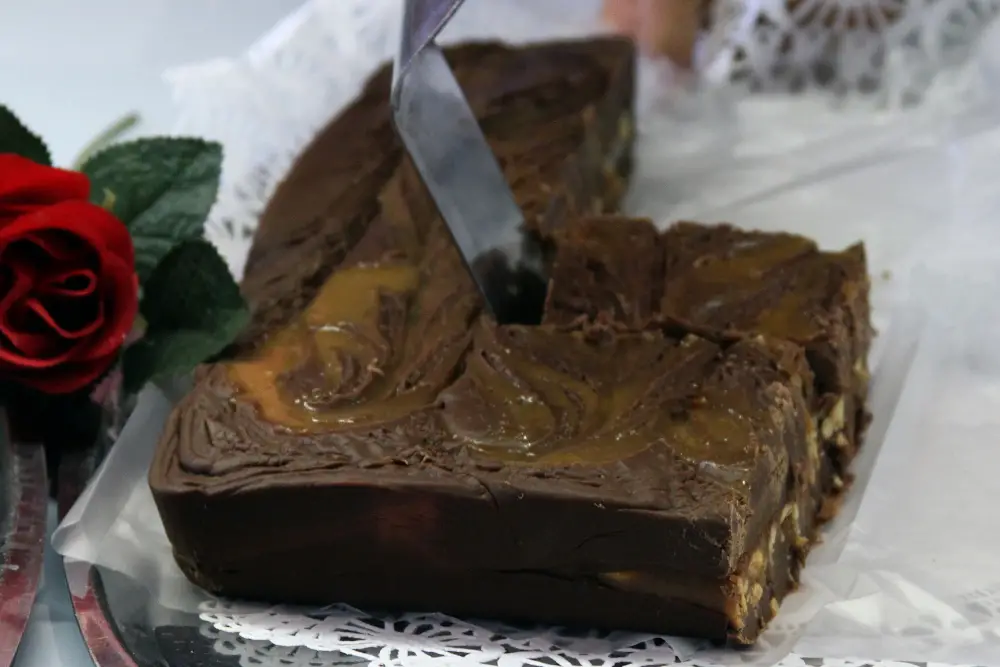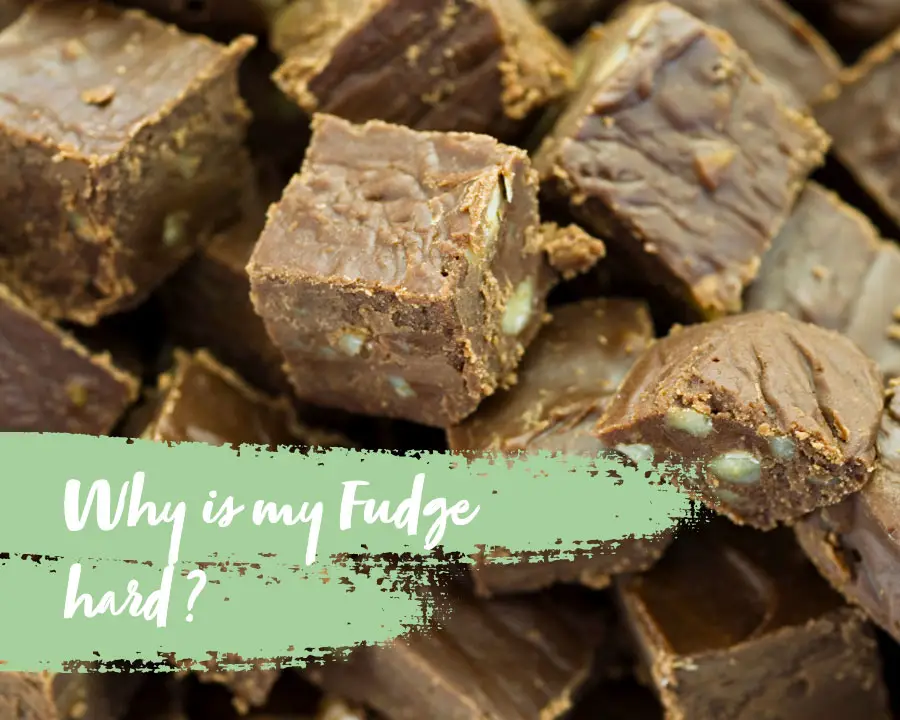It is important to notice what kind of fudge recipe you are using, as some recipes are easier than others. Old fashioned fudge can be a lot more tricky to get right, due to the temperature control that you need to get right.
To fix hard fudge you can save it by reboiling the fudge in a saucepan with water. When the fudge has dissolved and the water has evaporated, the fudge will be ready again to be beaten. Bear in mind that the key temperatures and the consistency of the fudge mixture are integral to fudge hardness.
However, there are a couple of reasons why your fudge is hard. Carry on reading to discover the cause of your hard fudge.
What Is Hard Fudge?
After mixing and melting your ingredients together, if you are making traditional/old fashioned fudge you are more likely to run into hard fudge.
This is because you need to be precise with your temperatures and how and when you beat your fudge mixture. There are ways that you can avoid this from happening and there are tricks to save your fudge if it has gone hard.
You only really suffer with hard fudge with traditional fudge recipes, therefore you are unlikely to come across this issue with quick fudge recipes.
This is fudge recipes that use marshmallow fluff or sweetened condensed milk to make the fudge like consistency. As stated, you are unlikely to have a hard fudge issue with quick fudge recipes, but it could happen if you overheat your ingredients so be careful.
Yet it is more likely with traditional fudge recipes.
Reasons For Hard Fudge
There are a couple of reasons as to why your fudge has set a lot harder than you expected. Your fudge may be as hard as a rock and therefore either difficult to cut or just crumbles when you try to cut it.
The following are a couple of reasons why your fudge might be hard and how to prevent this from happening next time.
Overcooked
Your fudge might be hard because you have overcooked the fudge mixture. The cooking time of your fudge directly affects the firmness of the end result.
If you cook the fudge for too long, then the fudge won’t contain enough water. This then results in your fudge setting really hard and having a very dry and crumbly texture which isn’t what you want.
To combat this you must keep an eye on the time specified on your recipe and try to follow it as much as possible. Eventually you’ll get the hang of it.
When it comes to traditional fudge, the more practise you have, the better you will become.
Beating The Fudge For Too Long
Beating the fudge is one of the most important and crucial parts of a traditional fudge recipe.
However, like with a cake recipe, over beating your fudge mixture is a bad thing to do. If you over beat your fudge then your fudge will set extremely hard.
To avoid over beating your fudge, you need to pay attention to the mixture. When your fudge mixture changes, you’ll notice that it will lose its glossy sheen. When this happens it’s time to stop beating your fudge.
Find yourself over beating fudge? Read this article from us Why Do You Beat Fudge? and our Ultimate guide to making fudge .
Temperature
Traditional fudge making is all about temperature. You need to make sure that your mixture gets to the right temperature ( 234 and 237 °F/ 112 and 114 °C )while it is being heated.
Then you need to make sure that you let your mixture cool to the correct temperature as well (109 to 113 °F/ 43 to 45 °C). If you mess up any of the temperatures, by rushing or waiting too long this can affect your fudge and make it go hard.
Having a candy thermometer is a really important piece of equipment when it comes to fudge making. You want to make sure that it is working correctly, as it will help you accurately see the temperature of your fudge mixture.
Therefore, less chance of overheating or underheating your mixture which could lead to hard fudge.
Can I Save My Hard Fudge?
If you do have a hard fudge there is a way you can save it and try to fix your fudge. If your fudge has a burnt flavor, then the fudge can’t be saved and you will need to start again.
However, if your fudge is just hard then follow these simple steps and you should be able to save your fudge.
- Scape your hard fudge into a large saucepan and add 1 ½ cups of water.
- Stir the fudge and water while on a low heat until everything is combined and all the water is gone.
(At this stage you may want to taste your fudge, because the water may have diluted the flavors of the fudge. This is the time to add more flavorings if you aren’t happy with the taste)
- Once you are happy with the taste and flavor of the fudge, now you need to turn the heat up to medium. You want to bring the fudge back up to the boil. A good tip is to wash down the sides of the saucepan with a wet pastry brush to prevent any sugar crystals forming.
At this point you shouldn’t stir your mixture.
- Now you need to cook your fudge to the temperature that has been specified in your recipe using your thermometer. This temperature is normally between 234 and 237 °F/ 112 and 114 °C.
- Once this temperature has met, it’s time to take your fudge off the heat and once again follow your recipes instructions for cooling and beating. When you are ready to beat your fudge, remember that you are waiting for your fudge to lose its sheen. That’s when you know that your fudge is ready.
By following these steps you should be able to save your hard fudge. Practice always makes perfect when it comes to traditional fudge.

Tips and Tricks
If you are new to making fudge it might be a good idea to start with quick fudge recipes, before you have a go at traditional fudge.
This is only due to traditional fudge being quite temperamental at times and it does take many attempts sometimes to get a good first batch. With quick fudge, you are a lot less likely to run into any hard fudge problems.
However once you are comfortable to move onto hard fudge recipes, remember that a candy thermometer is your best friend. There are a lot of candy thermometers (see Amazon ingredient prices via links) on the marker like JAKO Candy thermometer and the Taylor Precision Stainless Steel Candy Thermometer. You need to do some research to find a thermometer that you can trust to give you the correct temperatures.
Also you don’t want to over beat your fudge, so watching your fudge as you beat it is important. Take your time while beating so you can see this change. Otherwise pleasant and silky smooth fudge can turn hard within minutes.
In summary
Hard fudge is a very common problem when it comes to traditional fudge making. There are a couple reasons as to why your fudge has set extremely hard.
This is normally due to the fudge not being brought to the correct temperature or from over beating. There is a way to overcome hard fudge if you do run into this issue.
Fudge can be a delicious treat and gift, but sometimes the recipe doesn’t always work. Now you know how to fix you fudge and why it is so hard.

